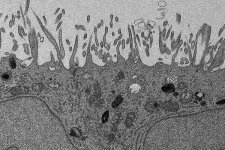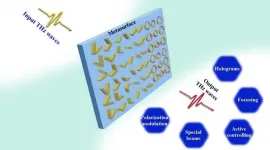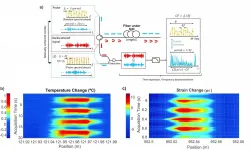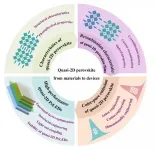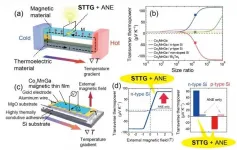(Press-News.org) LA JOLLA, CA--An analysis of thousands of genomes from people with and without the rare eye disease known as MacTel has turned up more than a dozen gene variants that are likely causing the condition to develop and worsen for a significant share of patients.
The discovery, by a team of scientists from Scripps Research and the Lowy Medical Research Institute, in collaboration with Columbia University in New York and UC San Diego, provides a new avenue to pursue for diagnosis and treatment. It also sheds light on fundamental aspects of metabolism in the retina, a tissue with one of the highest energy demands in the human body. Findings appear today in the journal Nature Metabolism.
"It's exciting to uncover new answers to the many questions surrounding this rare and complex eye disease," says Martin Friedlander, MD, PhD, professor at Scripps Research and president of the Lowy Medical Research Institute in La Jolla. "Although we've known that MacTel has a genetic component, the precise variants had remained elusive. These findings will serve as a springboard for further scientific investigation and as a guide to potential therapeutic targets."
MacTel, short for "macular telangiectasia type 2," is a progressive and debilitating eye disease that occurs in roughly one out of 5,000 people, or about 2 million people worldwide. A disease of the retina, the light-sensing tissue at the back of the eye, MacTel causes a gradual deterioration of central vision, interfering with critical tasks such as reading and driving.
Piecing together the puzzle
For more than 15 years, scientists have collaborated in an international effort, the MacTel Project, to find the cause of MacTel and develop treatments. Earlier studies found patients had low levels of an amino acid called serine in their bloodstream. However, while serine is essential for many biological processes, it was not known at that time to affect eye health.
In 2019, Friedlander and colleagues found the connection. They made a breakthrough discovery that low serine levels were responsible for a buildup of toxic lipids, which cause photoreceptor cells to die. But still, many questions remained. For example, what caused the decline in serine? The investigation continued.
In the new study, Rando Allikmets, PhD, of Columbia University, used an alternative approach to find genetic drivers of disease. Instead of assessing individual mutations in genes, he and his team analyzed groups of mutations, giving them a greater ability to identify disease-causing genes in a small population of people with MacTel.
One gene, PHGDH, had significantly more variants in MacTel patients than those without the disease. The team identified 22 rare variants in PHGDH which, together, account for approximately 3 to 4 percent of MacTel cases. Many more variants likely exist but haven't been found yet--a challenge considering the small patient population with diverse genetic causes.
Implications for other diseases
PHGDH is a key enzyme that enables the body to make serine, and these studies provided the long-sought link to low serine observed in MacTel patients. Its function is essential for the health of neurons in the eye and elsewhere in the body.
Several of the gene variants identified in the study are known to cause rare, severe neuropathies when both of the alleles, or copies of the gene, are affected. In the case of MacTel, only a single allele is affected, resulting in a partial loss of the enzyme function, which leads to retinal degeneration.
Many of these variants in PHGDH were identified for the first time and were predicted to cause defects in the gene, and Friedlander's group worked to confirm this. They directly tested whether each of the multitude of variants identified in MacTel patients are actually harmful to PHGDH function, and found they were.
"The PHGDH gene is essential for the production of serine, which plays a central role in cellular metabolism," says Kevin Eade, PhD, a former Scripps Research postdoctoral associate who is a senior scientist at the Lowy Medical Research Institute. "Through genetic analyses and experiments in human-derived retinal tissue, we were able confirm that even a partial loss of PHGDH function can have a damaging effect on the retina."
The scientists then used human induced pluripotent stem cells to generate specialized retinal cells that contained one of the MacTel-associated PHGDH mutations. They found that a PHGDH mutation in these cells leads to the production of a toxic lipid previously shown to cause MacTel.
Vision for a therapy
By more fully understanding the role of PHGDH in MacTel, scientists are hopeful they can begin to map out potential treatment approaches.
"We still have much to learn about this rare disease, including why systemic changes in serine metabolism leads to retinal degeneration," says Marin Gantner, PhD, senior staff scientist at the Lowy Medical Research Institute and doctoral graduate of Scripps Research. "We have come such a long way in identifying links to the disease, and every step provides new insights that can be leveraged in creating a therapy."
INFORMATION:
The study, "Serine biosynthesis defect due to haploinsufficiency of PHGDH causes retinal disease," was authored by Kevin Eade, Marin Gantner, Joseph Hostyk, Takayuki Nagasaki, Sarah Giles, Regis Fallon, Sarah Harkins-Perry, Michelle Baldini, Esther Lim, Lea Scheppke, Michael Dorrell, Carolyn Cai, Evan Baugh, Charles Wolock, Martina Wallace, Rebecca B. Berlow, David Goldstein, Christian Metallo, Martin Friedlander and Rando Allikmets.
The work was supported by the Lowy Family, the Lowy Medical Research Institute, the National Institutes of Health and Research to Prevent Blindness to the Department of Ophthalmology at Columbia University.
The cost of the rechargeable lithium-ion batteries used for phones, laptops, and cars has fallen dramatically over the last three decades, and has been a major driver of the rapid growth of those technologies. But attempting to quantify that cost decline has produced ambiguous and conflicting results that have hampered attempts to project the technology's future or devise useful policies and research priorities.
Now, MIT researchers have carried out an exhaustive analysis of the studies that have looked at the decline in the prices these batteries, which are the dominant rechargeable ...
Stuttgart - A team of scientists from the Max Planck Institute for Intelligent Systems (MPI-IS) in Germany, from Seoul National University in Korea and from the Harvard University in the US, successfully developed a predictive model and closed-loop controller of a soft robotic fish, designed to actively adjust its undulation amplitude to changing flow conditions and other external disturbances. Their work "Modeling and Control of a Soft Robotic Fish with Integrated Soft Sensing" was published in Wiley's Advanced Intelligent Systems journal, in a special issue on "Energy Storage and Delivery in Robotic Systems".
Each ...
THz waves have a plethora of applications ranging from biomedical and medical examinations, imaging, environment monitoring, to wireless communications, because of the abundant spectral information, low photon energy, strong penetrability, and shorter wavelength. THz waves with technological advances not only determined by the high-efficiency sources and detectors but also decided by a variety of the high-quality THz components/functional devices. However, traditional THz devices should be thick enough to realize the desired wave-manipulating functions, hindering the development of THz integrated systems and applications. Although metamaterials have been ...
Tailoring light is much like tailoring cloth, cutting and snipping to turn a bland fabric into one with some desired pattern. In the case of light, the tailoring is usually done in the spatial degrees of freedom, such as its amplitude and phase (the "pattern" of light), and its polarization, while the cutting and snipping might be control with spatial light modulators and the like. This burgeoning field is known as structured light, and is pushing the limits in what we can do with light, enabling us to see smaller, focus tighter, image with wider fields of view, probe with fewer photons, and to pack information ...
Distributed optical fiber sensing (DOFS) is currently a mature technology that allows "transforming" a conventional fiber optic into a continuous array of individual sensors, which are distributed along its length. Between the panoply of techniques developed in the field of DOFS, those based on phase-sensitive optical time-domain reflectometry (ΦOTDR) have gained a great deal of attention, mainly due to their ability to measure strain and temperature perturbations in real time. These unique features, along with other advantages of distributed sensors (reduced weight, electromagnetic immunity ...
Light-emitting diodes (LEDs) are changing the lighting and display industry and have obtained significant advances than traditional lighting sources. The traditional materials LEDs, e.g., III-V semiconductor LEDs, organic LEDs (OLEDs) and quantum-dot LEDs (QLEDs), have achieved great success and gradually realized commercialization, but still face some challenges. The OLEDs have the low carrier transport capability and exciton recombination, which would hinder the improvement of brightness. Besides, QLEDs show challenges for the tedious manufacturing process and the reliance on hydrophobic insulating long ligands also hinders their stability and electrical conductivity.
Compared with these traditional materials, quasi-2D ...
A large proportion of dementia deaths in England and Wales may be due to socioeconomic deprivation, according to new research led by Queen Mary University of London.
The team also found that socioeconomic deprivation was associated with younger age at death with dementia, and poorer access to accurate diagnosis.
Dementia is the leading cause of death in England and Wales, even during the COVID pandemic, and is the only disease in the top ten causes of death without effective treatment.
The research, published in the Journal of Alzheimer's Disease, examines Office for National Statistics mortality data for England and Wales, and finds that in 2017, 14,837 excess dementia deaths were attributable to deprivation, equating to 21.5 per cent of all dementia deaths ...
Uncovering detailed travel patterns and habitat use of sharks along and across shelf territories has been historically challenging - especially for most pelagic shark species - which remain offshore for most of their lives. Their vertical diving behavior has been a subject of inquiry for a long time, and for young sharks in particular, has remained elusive.
Using cutting-edge 3D satellite technology, a study led by Florida Atlantic University's Harbor Branch Oceanographic Institute, in collaboration with NOAA's National Marine Fisheries Service; OCEARCH; The South Fork Natural History Museum and Nature Center; and the Wildlife Conservation Society, is ...
Of the many perplexing questions surrounding SARS CoV-2, a mysterious new pathogen that has killed an estimated 2.6 million people worldwide, perhaps the most insistent is this: why does the illness seem to strike in such a haphazard way, sometimes sparing the 100 year old grandmother, while killing healthy young men and women in the prime of life?
A new study by Karen Anderson, Abhishek Singharoy and their colleagues at the Biodesign Institute at Arizona State University, may offer some tentative clues. Their research explores MHC-I, a critical protein component of the human adaptive immune system.
The research suggests that certain variant ...
A NIMS research team devised a new thermoelectric generation mechanism with a hybrid structure composed of thermoelectric and magnetic materials. The team then actually fabricated this structure and observed the record-high thermopower appearing in the direction perpendicular to a temperature gradient (i.e., transverse thermoelectric generation). These results may offer insights into new mechanisms and structural designs applicable to the development of versatile energy harvesting technologies and highly sensitive heat flux sensors.
The Seebeck effect is a phenomenon in which a temperature gradient across a metal or semiconductor is converted into a thermoelectric voltage. Because this effect can be used to convert waste heat into electrical energy, its potential applications (e.g., ...
